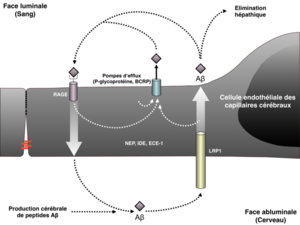Affecting more than 900.000 people only in France, Alzheimer's disease (AD) is now considered to be the most common cause of dementia in the elderly population. This disease mainly concerns individuals over 65 years old and constitutes an important threat to national public health. Nowadays, no effective therapeutic treatment against AD exists. Therefore, an urgent need consists in identifying the molecular mechanisms for development of preventive and therapeutic measures. Patients with AD develop two main pathological changes in the brain: neurofibrillary tangles, consisting in abnormal aggregates of hyperphosphorylated tau protein and amyloid plaques composed of deposits of abnormally aggregated amyloid β peptides (Aβ). Several researches suggested that these Aβ peptides, whose function remains unknown, are daily synthesized in our brain and are being eliminated by complex mechanisms. One of these elimination mechanisms involves the blood-brain barrier (BBB), which is located in the brain capillaries. This barrier isolates the brain from the rest of the body and closely controls the exchanges between blood and brain. How is this elimination carried out? What are the exact mechanisms involved? Is it possible to restore them for patients suffering from this pathology? In order to answer these questions, it is necessary to better understand how this barrier works.
However, because of its location and its unique structure, it is extremely difficult to study. The LBHE laboratory of the Université d’Artois, directed by the Professor Roméo Cecchelli, developed 20 years ago an in vitro model of the BBB. Since then, this BBB model has been improved and characterized and appears today to be one of the most relevant models in this field.
In response of growing evidence of the important role of the BBB in Alzheimer's disease, the Prof. Professor Cecchelli created a team within his laboratory co-led by the Prof. Laurence Fenart-Tilloy and Prof. Fabien Gosselet, to better understand the mechanisms underlying the elimination of these peptides.
Their work has been the subject of a journal published in Medicine / Science. Even if these mechanisms are not yet fully deciphered and understood, it is still necessary to continue the efforts made in this field with the hope that one day, research will succeed in developing new therapeutic strategies and could, why not, restore or improve the elimination of these peptides for patients with this disease.

|
| Amyloid exchange between the brain and the blood. From Gosselet F. et al., La barrière hémato-encéphalique. Une nouvelle cible thérapeutique dans la maladie d’Alzheimer ? Med Sci (Paris). Volume 27, Numéro 11, Novembre 2011. Page(s) 987 - 992. |